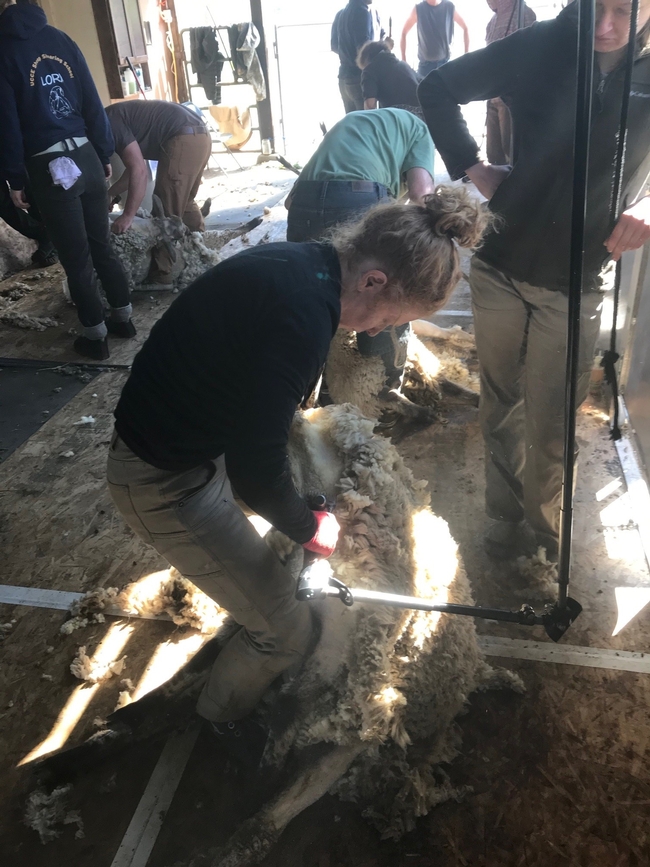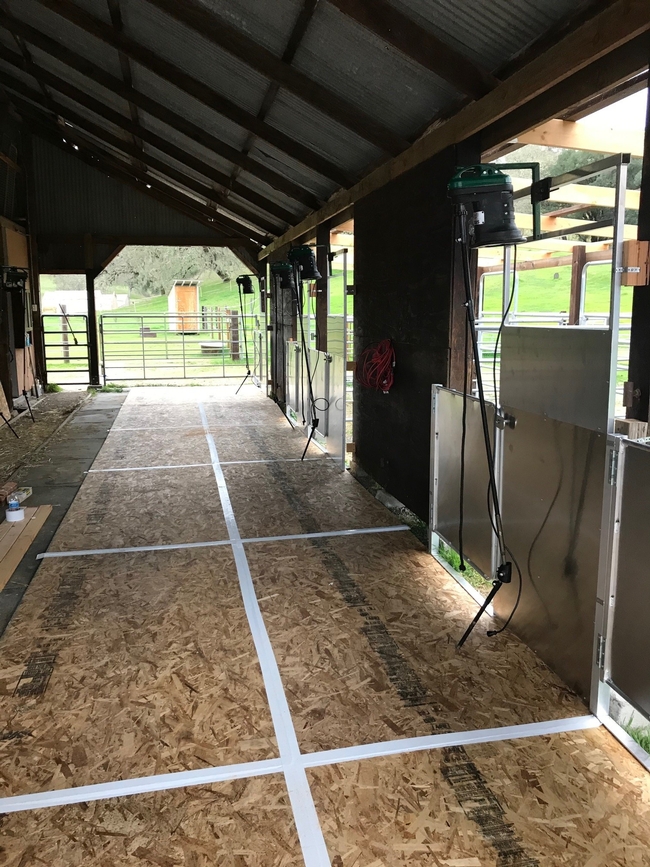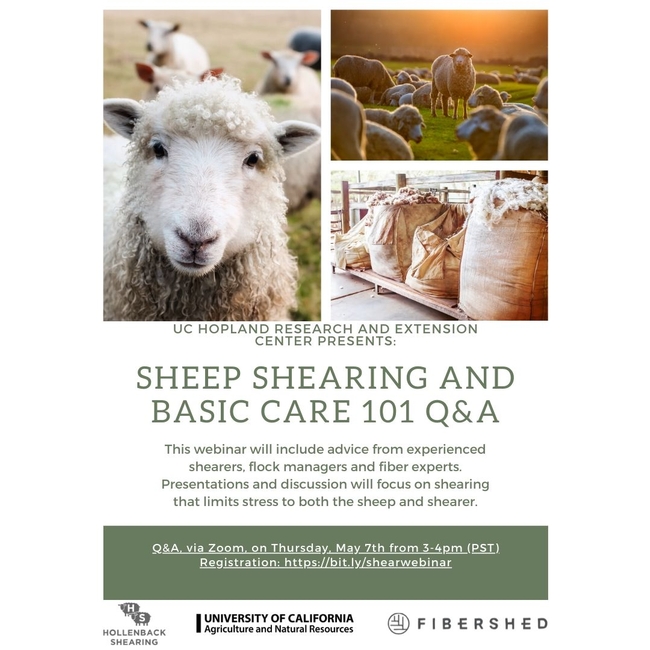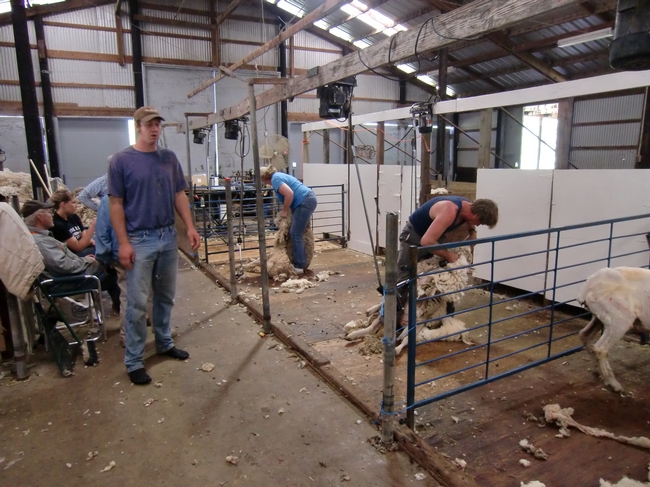
Posts Tagged: Sheep Shearing
Opportunity to Support the US Sheep Shearing Team at the Golden Shears World Championships
Support the American Shearing Team
Producers looking to support the American team headed to the Golden Shears World Championships next month in Scotland can do so by purchasing a Team USA T-shirt or hoodie offered through American Hero Clothing.
The T-shirt sells for $30 and the hoodie for $60. A portion of the proceeds will support travel expenses for the American team.
Click Here to buy the T-shirt.
Click Hereto buy the Hoodie.
Source: American Sheep Shearers Council
UCCE Week-Long Sheep Shearing School is Back in 2023!!!
After two years of Covid restrictions, I'm happy to say that I'll be doing our very popular week-long shearing school. The dates are March 20th through 24th, 2023. It will be located once again at the Twinning Barn near Ukiah.
We will limit the class size to 28 students and we will have 5 instructors including me. The cost is $850 and is not refundable for partial participation. California residents will receive priority and local Mendocino and Lake County students can apply for a scholarship to reduce the cost of enrollment. Scholarships are awarded only after a student completes the course.
As we've done in the past, we ask folks to fill out the interest survey here https://surveys.ucanr.edu/survey.cfm?surveynumber=39994. Make sure you complete the survey immediately if you haven't done so in the past.
We will provide instructions on how and when to register on-line with a credit card
(Visa or Mastercard) only to those on the interest survey list. It is a separate survey.
With the exceptions already noted here, when registration opens on-line it will be a first come first in for the 28 slots. If you are on our interest list from years past and have never gotten in, please write an email to me, John Harper, jmharper@ucanr.edu and describe why you want to take the course. In past years the on-line class has filled in under 2 minutes.
We will take a few extras on the registration as alternates to be contacted if successful registrants' have to cancel before the first week prior to the school
.
Webinar: Sheep shearing and basic care 101
The University of California Hopland Research and Extension Center (HREC) will offer a sheep shearing and basic care Q&A via Zoom from 3 to 4 p.m. May 7. The session will include advice from experienced shearers, flock managers and fiber experts.
Presentations and discussion will focus on shearing that limits stress to both the sheep and shearer. We also encourage your questions regarding sheep handling, husbandry, flock health, running a mobile shearing service, ethical shearing, grazing for fuel reduction and climate beneficial ranching practices. This webinar will take the place of the planned Sheep Shearing and Basic Care 101 immersive workshop planned at HREC in Spring 2020.
Participants in the webinar may also be interested in learning more about the class planned for 2021. Due to these unprecedented times, you do not have to have been registered for the Sheep Shearing 101 class to attend this Q&A session.
The session is free, but registration is required. Click here to register for the webinar and to share your questions.
Speakers:
Ruthie King
King is a shepherd focused on intensive rotational grazing for soil building, ecosystem restoration, fuel reduction and nutrient/water cycling. She raises Icelandic and Targhee sheep and sells meat, wool, and pelts through direct marketing. Services she offers include sheep shearing and contract grazing.
Alison Smith
Smith is the shepherd of the flock of over 200 sheep at the UC Hopland Research and Extension Center. She also supports research and extension at the site.
Trevor Hollenback
Owner/operator of Hollenback Shearing, Hollenback has been professionally trained and employed as a shearer in the United States, New Zealand, Australia, and Austria. His primary focus in shearing is limiting stress to both the sheep and shearer.
Rebecca Burgess
Burgess is the executive director of Fibershed, chair of the board for Carbon Cycle Institute, and the author of “Harvesting Color.” A vocationally trained weaver and natural dyer, she creates hands-on curricula that focus on restoration ecology and fiber systems. Burgess has built an extensive network of farmers and artisans in the Northern California Fibershed to pilot an innovative fiber systems model at the community scale.
UC sheep shearing school prepares students for gainful employment

“I tell my sheep shearing students, ‘You'll never be unemployed,'” said John Harper, UC Cooperative Extension livestock and natural resources advisor in Mendocino County. “And you'll never be poor.”
Shearers can earn $50 to $100 per hour, Harper said, and can start a business with a $3,000 investment in equipment.
“If they can learn how to shear sheep correctly, it's a great little business to get into,” Harper said.
The need for skilled sheep shearers in California and other parts of the nation has prompted the UC Hopland Research and Extension Center to host an annual sheep shearing school, where a diversity of students are introduced to a trade that allows them to work with their hands, out-of-doors, when and where they want.
Although sheep shearing is traditionally a male occupation, Harper said he encourages women to take the course.
“Women have a lower center of gravity. Strength is important, but so is hip rotation,” Harper said. “The sheep's skin is very loose and the blades are pretty powerful. The female students tend to be more cautious and we see fewer nicks.”
Beatrice Thomas, 41, is a typical student.
“I came to sheep shearing by way of dance and the arts,” Thomas said.
She left her Bay Area desk job about a year ago. “There wasn't a mind-body connection,” she said. “Forty hours at a desk, my body was aching.”
But sheep shearing was a completely different experience.
“This doesn't hurt the same way as sitting at a desk, because it feels vital. Every move is important. There's a dance. There's a rhythm. My whole spirit lit up,” Thomas said.
The 5,200-acre Hopland Research and Extension Center is home to a flock of about 1,000 sheep, which provide opportunities for scientists to study their role in land management. They also serve as a ready supply of animals for prospective new shearers to learn the craft.
“We teach students how to shear in a way that ensures the welfare of the sheep, produces a quality wool clip, and keeps the shearers safe,” Harper said. “We received a grant from the National Sheep Industry Improvement Association to purchase new shearing equipment. This allows the students to learn with brand new, state-of-the-art combs, cutters and hand pieces.”
The annual sheep shearing school at Hopland is the only intensive five-day course in the United States, said Hannah Bird, community educator at the research center.
“It brings people from all over the country and sometimes outside the country,” she said.
The week together helps build camaraderies amongst the newly trained sheep shearers. Hopland sheep shearing alums have created a Facebook group to stay in touch and refer jobs to one another. Several previous students are making a living a sheep shearing. One is Stephany Wilkes, a 2013 sheep shearing student who now runs her own sheep shearing business from San Francisco.
“People always ask me, ‘How can you run a sheep shearing business and live in the city?'” Wilkes said. “But there are actually a lot of sheep in the Bay Area, in Marin County, Solano and Yolo. I shear in Hayward and as far south as Gilroy. I go can go anywhere a car can.”
Lead instructor Gary Vorderbruggen said a key to sheep shearing success is a calm demeanor.
“Sheep don't need to be riled up. If you can be calm, and be safe, you will gain speed with experience,” Vorderbruggen said. “It's no different than a dance. It's like a square dance, except you're doing that square dance with an unwilling partner.”
Joining Harper and Vorderbruggen instructing the class in 2016 was Trevor Hollenback. He was first exposed to sheep shearing when visiting a friend's sheep farm in Austria.
“I realized this is a really skilled craft. It's amazing,” Hollenback said.
Hollenback quit his desk job and traveled to New Zealand for training, then returned to the Austrian farm for more practice. Back in the United States, Hollenback opened his own business and began shearing sheep in California and Arizona. He was tapped to be the instructor at Hopland because of his formal training in New Zealand.
“One of the most important things that the students can take away from this course is going to be sheep handling, how to move the sheep around, how to control the sheep on the board,” Hollenback said. “A lot of students came here with very little background in livestock. Footwork, positions, getting the pattern down – all the finer points in shearing – that comes with practice.”
The week-long sheep shearing school at Hopland will be held again in spring 2017. The class typically fills up within two hours of opening registration. Register interest on the UCCE Mendocino website to be notified when registration opens.
View scenes from the 2016 Sheep Shearing School at Hopland in the video below:
'Wild and wooly' sheep shearing class held at Hopland

Reporter Justine Frederiksen of the Ukiah Daily Journal also reported on the sold-out sheep shearing and wool classing training at the 5,300-acre Mendocino County research center.
“And 60 percent of these people had never even touched a sheep before,” said John Harper, UCCE advisor and shearing school leader. Nearly all the students were women and included an artist from San Francisco, a retired fire chief, a UC Davis graduate student, and a woman who was learning to shear ahead of travels to New Zealand “because I think it will be a good skill to have for work, in case I want to stay for a couple of months.”
“One of the things new students have the most trouble with is what we call ‘tipping' the sheep, or flipping them over,” Harper said. He explained that, to get the sheep into the ideal starting position, you need to push its back legs down with one hand and tuck its head in with the other, twisting the animal into a sitting position with all four legs dangling.
UC Hopland REC sheep shearing students are part of a new wave of sheep shearers and wool enthusiasts industry officials hope will reverse decades of disinterest and decline. The shearing classes were booked well ahead of time, said Hannah Bird, a community educator at the research station. Many students are seeking a break from city life or jobs tying them to a desk.
Wrote reporter Glenda Anderson, shearing sheep is sweaty, back-straining work that earns just $2 to $5 per sheep. But an expert sheep shearer taking part in the program said sheep shearing for a living has its benefits.
“It's a lifestyle thing. I could work six months a year and travel around the world,” paying for the travel by working here and there, he said.




